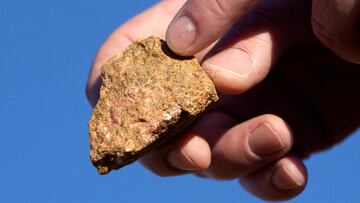China dominates the rare earth element market: What is US government doing to increase global supply?
Rare earth metals are needed to make electric cars, wind turbines, and more. With China dominating the market, the US is scaling up its focus on mining.


Rare earth minerals are metallic elements found in the earth’s crust which can be processed into increasingly vauable commodities. These elements and metals are used to make the motors for hybrid and electric cars, generators for wind turbines, military-grade weapons, and other technologies.
Contrary to the name, the concentration of these elements within the earth’s surface is actually quite high. Economically, however, finding high concentrations in a specific area is “rare,” making establishing a mine and processing center costly.
Radioactivity and environmental danger
Additionally, when the minerals are refined, they often need to be separated from other elements like uranium which has radioactive properties. As the minerals are processed, Technologically Enhanced Naturally Occurring Radioactive Materials (TENORM) are created as a byproduct. The Environmental Protection Agency defines as TENORMs as “naturally occurring radioactive materials that have been concentrated or exposed to the accessible environment as a result of human activities such as manufacturing, mineral extraction, or water processing.”
If these materials are not disposed of properly, there can be severe environmental consequences. Still, the industry is identifying the proper ways to store or dispose of these materials, and no clear consensus has been reached. Currently there are no processing facilities in the United States over fears of radioactive leakage. There is, however, one mine near San Bernadino, California called Mountian Pass where the element bastnäsite is mined.
China enters the rare earth element market
In the early 1990s, China entered the rare earth mineral mining and processing sector. Three decades later the country dominates the landscape. The rise of China in this sector came as many mines in the United States scaled back their operations over concerns of the possible environmental damage. By 2011, China produced ninety-five percent of all rare earth minerals, and US dependence on Chinese markets became a serious concern.
Between 2008 and 2012, the Chinese government exerted strong regulatory control over the sector, primarily by limiting the supply able to be exported, to ensure price stability.
China taken to the World Trade Organization
From 2008 to 2012, China reduced its export restrictions, leading to dramatic price increases. These protectionist policies were brought to the World Trade Organization, where it was determined that
China had violated rules by imposing “export duties, export quotas, and certain limitations on the enterprises permitted to export the products.” This final violation is based on the organization’s “principle of non-discrimination” because other parties believed China was giving preferential treatment to domestic producers and exporters.
To comply with the WTO decision and maintain control of the market, China repealed the export quotas and began flooding the market, offering low prices that other firms could not compete with. The only rare earth mining company in the United States, Molycorp, which owned the Mountain Pass mine and was sold at auction after suffering severe losses.
The company was pucharsed by MP Materials Corp., and as of December 2021, the partially state-owned Chinese mining company, Shenghe Resources, owned 7.7 percent of the company. In early 2021, Quartz reported that Sheghe Resources was the sole buyer of the materials mined at the Mountain Pass facility, all of which was sent to China for processing.
The US makes efforts to decrease dependence on Chinese rare earth mineral exports
As the country with one of the highest concentration of rare earth mineral reserves and massive processing capabilities, China has a lot of control in the market. Current, rare earth exports from China around seventy-two percent of global supply. Australia is the second-largest supplier but only accounts for about eleven percent of the total market. The United States imports seventy-eight percent of its rare earth metals from China, followed by Estonia (6 percent), Malaysia (5 percent), and Japan (4 percent).
| Country | Production (2021) | Change (2020-2021) | Reserves |
|---|---|---|---|
| China | 168,000 | +18,000 | 44,000,000 |
| United States | 43,000 | +4,000 | 1,800,000 |
| Myanmar | 26,000 | -5,000 | N/A |
| Australia | 22,000 | +1,000 | 4,000,000 |
Last year the Department of Defense (DoD) announced the release of a grant to support increased production of rare earth elements domestically.
In February, the DoD released a statement detailing the $35 million contract awarded to MP Materials Corp. (MP). The bid expands the company’s Mountain Pass production site in California. It will “establish the first processing and separation facility of its kind for [heavy rare earth elements] in support of both defense and commercial applications in the United States.” Howver, even if in the long-term the US is able to boost its processing capabilities, China can use its market power to stifle US efforts to make its market more competitive. If China can offer processing services at much more affordable rates, business is likely to stay in China, unless the federal government begins to subsidize the industry.
MP Materials seeking to deliver an “end-to-end supply chain”
Last week, MP Materials signed an agreement with General Motors “to produce rare earth alloy and magnets for GM’s EV programs.” The agreement will begin in late 2023, but MP Materials is getting started by builing a new facility in Texas. The long-term goal is to see the facility deliver “an end-to-end supply chain,” by expanding their services to incldue “refining, metal, alloy, and magnet manufacturing, and recycling.”
The raw materials needed will be sourced from the Mountain Pass mine. The environemnetal dangers have not been discuseed by the comapny, but were alluded to in the press release.
Related stories
“Mountain Pass is a closed loop, zero-discharge facility with a dry tailings process that recycles more than 1.7 billion liters of water per year. To optimize for efficiency and sustainability, byproduct generated from alloy and magnet manufacturing will be recycled in a closed loop to every extent possible,” reads the statement.
When it comes to mining, water is essential, and a closed loop implies that water is reused throughout the process to minimize usage. Unfortunately it can only be reused so many times before it becomes briny and mixes with other materials. The danger here comes if radioactive material mixes with the water and there is a leak or the levels are not being adequately measured and verified.

